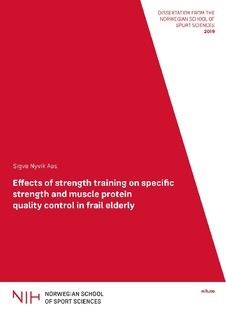| dc.description.abstract | With aging, the loss of muscle strength exceeds the loss of muscle mass. Specific strength, defined as strength normalized to the cross-sectional area of a muscle or muscle group, declines accordingly. A reduced voluntary activation level may explain some of the decline in specific strength, but also decreased muscle quality appears to be involved. Autophagy is responsible for the degradation of dysfunctional proteins and organelles in muscle cells, and studies in rodents suggest that autophagy is impaired with aging. Whether or not autophagy is impaired with aging also in humans, and whether a possible decline in autophagic activity contributes to the reduction in muscle quality, remains to be investigated. Contrary to aging, specific strength increases following a period of strength training, and this is particularly clear in frail elderly. However, the relative contribution from changes in activation level and muscle quality is not known. Moreover, whether or not changes in protein quality control systems contribute to improved muscle quality has not been investigated. The main goal of this thesis was to investigate the effect of heavy load strength training on a broad number of factors related to specific strength in pre-frail and frail elderly. In addition, a cross-sectional study was conducted to assess if autophagy is different in elderly and frail compared to healthy and young humans.
In total, 93 men and women (17 young, 76 old) were included in the studies. In the cross-sectional study, the following four groups were compared: Young, old non-frail, old pre-frail and old frail. Specific strength was measured as maximal isometric knee extension torque (MVC) normalized to leg lean mass assessed by DXA. Muscle biopsies were obtained from the vastus lateralis muscle, and analyzed for proteins related to muscle protein synthesis (p70S6K, 4E-BP1, eEF2), autophagy (p62, LC3-I, LC3-II) and cellular stress (heat shock proteins; Hsp70, αB-crystallin) by western blot. In the main intervention study, pre-frail and frail elderly underwent heavy load strength training twice weekly for ten weeks. Specific strength was measured as knee extension MVC normalized to cross-sectional area (CSA) of the quadriceps femoris muscles, assessed by computed tomography (CT). Voluntary activation level was assessed by the twitch interpolation technique, intermuscular adipose tissue (IMAT) and muscle density by CT, and intramyocellular lipids (IMCL) by Oil Red O staining on muscle biopsy sections. In addition, single fiber specific tension was investigated, and the biopsies were also analyzed for proteins related to muscle protein synthesis, autophagy and cellular stress. Functional capacity was assessed by five times chair rise time and gait velocity.
In the cross-sectional study, specific strength was lowest in old frail subjects. No between-group differences were observed for p70S6K, 4E-BP1, eEF2 or p62, whereas the levels of LC3-I, LC3-II and certain heat shock proteins (HSPs) were higher in the elderly subjects. Higher levels of LC3-I and LC3-II might reflect attenuated fusion of autophagosomes and lysosomes, and higher levels of HSPs might indicate increased levels of denatured and dysfunctional proteins. In the intervention study, a strong correlation was observed between quadriceps femoris CSA and knee extension MVC at baseline (r = 0.89, P < 0.01). The training intervention did not elicit changes in activation level, IMAT, IMCL or single fiber specific tension. An increase in muscle density was observed, but increased density was not correlated with changes in IMCL content or single fiber specific tension. The intervention had limited effects on autophagy proteins and HSPs. In contrast to our hypothesis, the increase in quadriceps femoris CSA (7%) corresponded well with the improvements in knee extension MVC (7%). The training intervention improved habitual and maximal gait velocity, but not five times chair rise time.
In contrast to several previous studies, our findings suggest that even in pre-frail and frail elderly, most of the variation in muscle strength is explained by differences in muscle cross-sectional area. Moreover, the training-induced increase in muscle strength was primarily due to increased muscle quantity, not quality in our study. Nevertheless, we found indications of impaired autophagy and higher cellular stress in elderly and frail individuals compared to young and healthy individuals. Furthermore, specific strength was lowest in the elderly and frail, and within the elderly there was a correlation between markers of autophagy and specific strength, supporting a possible relation between impaired protein quality control and reduced muscle quality. Altogether, impaired autophagy may play a role in the age-associated decline in specific strength, but muscle mass seems to be the most important determinant of muscle strength and function even in old and frail individuals. It is too early to conclude that strength training does not affect protein quality control systems in this population, and it is possible that a higher frequency or longer duration of training is required to elicit greater changes. | en |
| dc.description.abstract | Paper I: Aas SN, Seynnes O, Benestad HB, Raastad T. Strength training and protein supplementation improve muscle mass, strength, and function in old pre-frail individuals. Submitted.
Paper II: Aas SN, Hamarsland H, Cumming TC, Rognlien SH, Aase OJ, Nordseth M, Karsrud S, Godager S, Tømmerbakke D, Handegard V, Raastad T. The impact of age and frailty on skeletal muscle autophagy markers and specific strength: A cross-sectional comparison. Manuscript.
Paper III: Aas SN, Breit M, Karsrud S, Aase OJ, Rognlien SH, Cumming KT, Reggiani C, Seynnes O, Rossi AP, Toniolo L, Raastad T. Effects of 10 weeks of heavy load strength training on muscle activation level, muscle quality and single fiber function in frail elderly men and women. Manuscript.
Paper IV: Aas SN, Tømmerbakke D, Godager S, Nordseth M, Armani A, Sandri M, Benestad HB, Raastad T. Effects of acute and long-term strength training on skeletal muscle autophagy in frail elderly men and women. Manuscript. | en |
